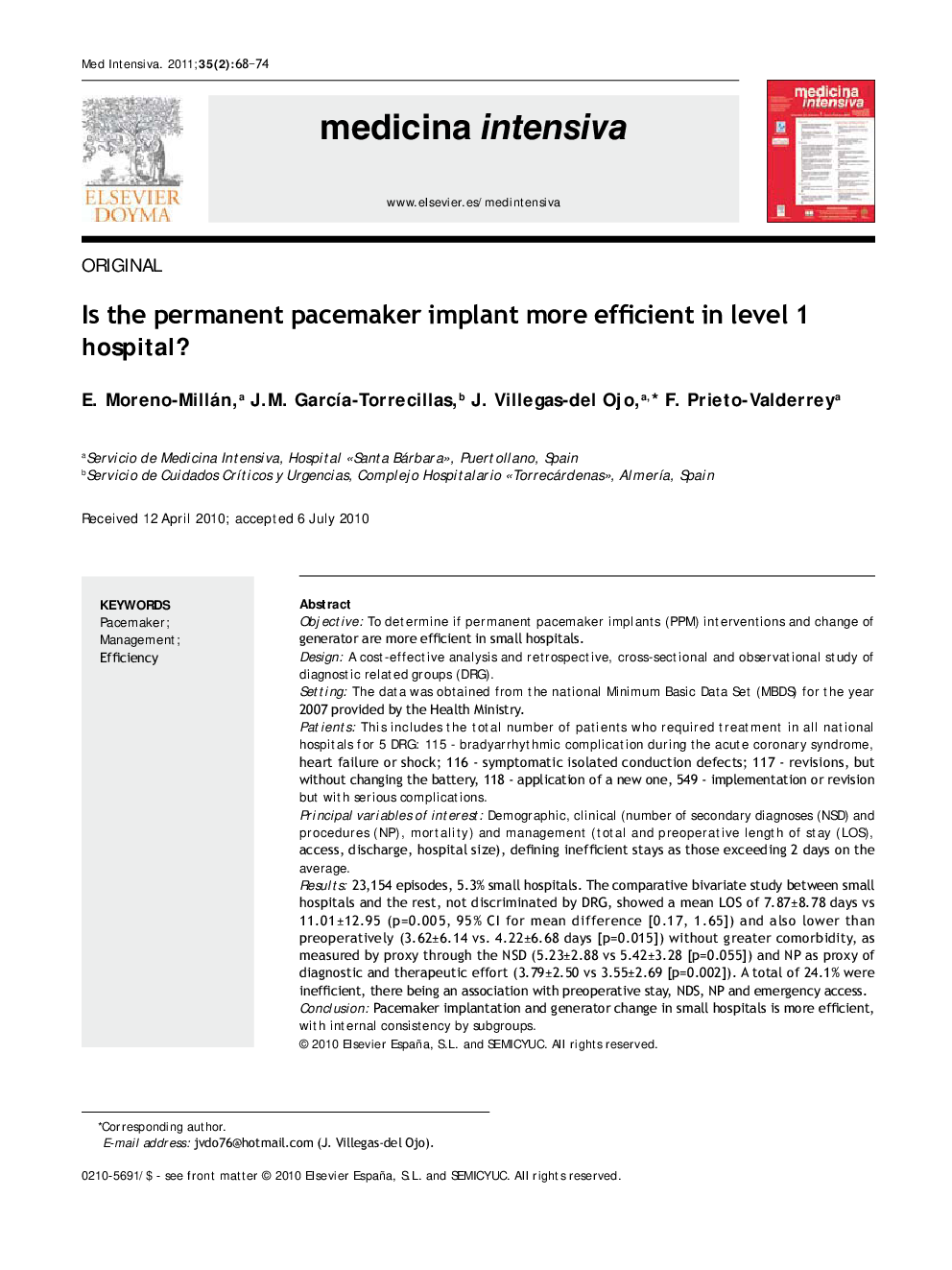| Article ID | Journal | Published Year | Pages | File Type |
|---|---|---|---|---|
| 3114291 | Medicina Intensiva (English Edition) | 2011 | 7 Pages |
ObjectiveTo determine if permanent pacemaker implants (PPM) interventions and change of generator are more efficient in small hospitals.DesignA cost-effective analysis and retrospective, cross-sectional and observational study of diagnostic related groups (DRG).SettingThe data was obtained from the national Minimum Basic Data Set (MBDS) for the year 2007 provided by the Health Ministry.PatientsThis includes the total number of patients who required treatment in all national hospitals for 5 DRG: 115 - bradyarrhythmic complication during the acute coronary syndrome, heart failure or shock; 116 - symptomatic isolated conduction defects; 117 - revisions, but without changing the battery, 118 - application of a new one, 549 - implementation or revision but with serious complications.Principal variables of interestDemographic, clinical (number of secondary diagnoses (NSD) and procedures (NP), mortality) and management (total and preoperative length of stay (LOS), access, discharge, hospital size), defining inefficient stays as those exceeding 2 days on the average.Results23,154 episodes, 5.3% small hospitals. The comparative bivariate study between small hospitals and the rest, not discriminated by DRG, showed a mean LOS of 7.87 ± 8.78 days vs 11.01 ± 12.95 (p = 0.005, 95% CI for mean difference [0.17, 1.65]) and also lower than preoperatively (3.62 ± 6.14 vs. 4.22 ± 6.68 days [p = 0.015]) without greater comorbidity, as measured by proxy through the NSD (5.23 ± 2.88 vs 5.42 ± 3.28 [p = 0.055]) and NP as proxy of diagnostic and therapeutic effort (3.79 ± 2.50 vs 3.55 ± 2.69 [p = 0.002]). A total of 24.1% were inefficient, there being an association with preoperative stay, NDS, NP and emergency access.ConclusionPacemaker implantation and generator change in small hospitals is more efficient, with internal consistency by subgroups.
ResumenObjetivoDeterminar si el implante de marcapasos permanentes (MPP) y cambio de generador resultan más eficientes en hospitales pequeños.DiseñoAnálisis de costeefectividad. Estudio retrospectivo, transversal y observacional de cinco GDR.ÁmbitoLos datos son procedentes del conjunto mínimo básico de datos (CMBD) nacional del año 2007, facilitado por el Ministerio de Sanidad.PacientesSon el total de los pacientes que requirieron asistencia en algún hospital nacional por 5 GRD: 115, complicación bradiarrítmica durante la fase aguda de un síndrome coronario, insuficiencia cardíaca o shock; 116, trastorno de conducción sintomático aislado; 117, revisión pero sin cambio de batería; 118, aplicación de una nueva, y 549, implantación o revisión pero con complicaciones graves.Variables de interés principalesSe analizaron variables demográficas, clínicas (número de diagnósticos secundarios [NDS], de procedimientos [NP], mortalidad) y de gestión (estancia total y preoperatoria [Epo], forma de acceso y alta, tamaño de hospital), definiendo ineficiente una estancia superior 2 días a la media.Resultados23.154 episodios (5,3% en hospitales < 200 camas). El estudio bivariado comparativo entre hospitales pequeños y el resto, no discriminado por GDR, mostró estancia media 7,87 ± 11,01 días vs. 8,78 ± 12,95 (p = 0,005, IC 95% [0,17; 1,65]) y Epo 3,62 ± 6,14 vs. 4,22 ± 6,68 días [p = 0,015]), sin mayor comorbilidad, medida como proxy por NDS (5,23 ± 2,88 vs. 5,42 ± 3,28 [p = 0,055]); y NP como proxy de esfuerzo diagnóstico-terapéutico (3,79 ± 2,50 vs. 3,55 ± 2,69 [p = 0,002]). 24,1% fueron ineficientes, encontrándose asociación con Epo, NDS, NP y acceso urgente.ConclusionesLa implantación de marcapasos y cambio de generador en hospitales pequeños es más eficiente, con consistencia interna por subgrupos.
